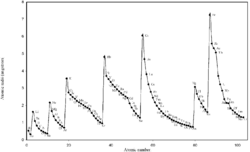Ångström
 From HandWiki - Reading time: 5 min
From HandWiki - Reading time: 5 min
| Angstrom | |
|---|---|
| Unit of | Length |
| Symbol | Å |
| Named after | Anders Jonas Ångström |
| Conversions | |
| 1 Å in ... | ... is equal to ... |
| metres | 10−10 m |
| centimetres | 10−8 cm |
| micrometres | 10−4 μm |
| nanometres | 0.1 nm |
| picometres | 100 pm |
The ångström (/ˈæŋstrəm, -strʌm/,[1][2]ANG-strəm; ANG-strum Swedish: [²ɔŋːstrœm])[1] or angstrom is a unit of length equal to 10−10 m (one ten-billionth of a metre) or 0.1 nanometre. Its symbol is Å, a letter in the Swedish alphabet.
The natural sciences and technology often use ångström to express sizes of atoms, molecules, microscopic biological structures, and lengths of chemical bonds, arrangement of atoms in crystals, wavelengths of electromagnetic radiation, and dimensions of integrated circuit parts. Atoms of phosphorus, sulfur, and chlorine are about an ångström in covalent radius, while a hydrogen atom is about half an ångström; see atomic radius. Visible light has wavelengths in the range of 4000–7000 Å.
The unit is named after the Swedish physicist Anders Jonas Ångström (1814–1874). The symbol is always written with a ring diacritic, as the letter in the Swedish alphabet. The unit's name is often written in English without the diacritics,[3] but the official definitions do contain them.[4][5] It is not a part of the SI system of units; although it can be considered part of the metric system.
Use
The ångström is used extensively in crystallography, solid-state physics and chemistry as a unit for d-spacings (the distance between atomic planes in a crystal[6]), cell parameters, inter-atomic distances and x-ray wavelengths, as these values are often in the 1–10 Å range. For example, the Inorganic Crystal Structure Database[7] presents all these values using the ångström.
History
Anders Jonas Ångström was a pioneer in the field of spectroscopy, and he is also well known for his studies of astrophysics, heat transfer, terrestrial magnetism, and the aurora borealis. In 1852, Ångström formulated in Optiska undersökningar,[8] in English translation Optical Researches,[9] a law of absorption, later modified somewhat and known as Kirchhoff's law of thermal radiation.
In 1868, Ångström created a chart of the spectrum of sunlight, in which he expressed the wavelengths of electromagnetic radiation in the electromagnetic spectrum in multiples of one ten-millionth of a millimetre (or 10−7 mm.)[10] Because the human eye is sensitive to wavelengths from about 4000 to 7000 Å (visible light), that choice of unit supported sufficiently accurate measurements of visible wavelengths without resorting to fractional numbers.[citation needed] Ångström's chart and table of wavelengths in the solar spectrum became widely used in solar physics, which adopted the unit and named it after him. It subsequently spread to the rest of astronomical spectroscopy, atomic spectroscopy, and subsequently to other sciences that deal with atomic-scale structures.
Though intended to correspond to 10−10 metres, for precise spectral analysis, the ångström had to be defined more accurately than the metre, which until 1960 was still defined based on the length of a bar of metal held in Paris. The use of metal bars had been involved in an early error in the value of the ångström of about one part in 6000. Ångström took the precaution of having the standard bar he used checked against a standard in Paris, but the metrologist Henri Tresca reported it to be so much shorter than it really was that Ångström's corrected results were more in error than the uncorrected ones.[11]
In 1892–1895, Albert A. Michelson defined the ångström so that the red line of cadmium was equal to 6438.47 ångströms.[12] In 1907, the International Union for Cooperation in Solar Research (which later became the International Astronomical Union) defined the international ångström by declaring the wavelength of the red line of cadmium (in dry air at 15 °C (hydrogen scale) and 760 mmHg under a gravity of 9.8067 m/s²) equal to 6438.4696 international ångströms, and this definition was endorsed by the International Bureau of Weights and Measures in 1927.[13][14] From 1927 to 1960, the ångström remained a secondary unit of length for use in spectroscopy, defined separately from the metre. In 1960, the metre itself was redefined in spectroscopic terms, which allowed the ångström to be redefined as being exactly 0.1 nanometres.
The ångström is internationally recognized, but is not a formal part of the International System of Units (SI). The closest SI unit is the nanometre (10−9 m). The International Committee for Weights and Measures officially discourages its use, and it is not included in the European Union's catalogue of units of measure that may be used within its internal market.[15]
Symbol

For compatibility reasons, Unicode includes the formal symbol at U+212B Å ANGSTROM SIGN (HTML Å). However, the ångström sign is also normalized into U+00C5 Å LATIN CAPITAL LETTER A WITH RING ABOVE (HTML Å · Å)[16] The Unicode consortium recommends to use the regular letter (00C5).
Before digital typesetting, the ångström (or ångström unit) was sometimes written as "A.U." (also an abbreviation of the astronomical unit). This use is evident in Bragg's paper on the structure of ice,[17] which gives the c- and a-axis lattice constants as 4.52 A.U. and 7.34 A.U., respectively. Nowadays the atomic unit of length (a.u.) usually stands for bohrs, not ångströms.
See also
- 100 picometres
- X unit
- Conversion of units
References
- ↑ 1.0 1.1 Wells, John C. (2008), Longman Pronunciation Dictionary (3rd ed.), Longman, ISBN 9781405881180
- ↑ Roach, Peter (2011), Cambridge English Pronouncing Dictionary (18th ed.), Cambridge: Cambridge University Press, ISBN 9780521152532
- ↑ Webster′s Encyclopedic Unabridged Dictionary of the English Language. Portland House, 1989
- ↑ International Bureau of Weights and Measures (2006), The International System of Units (SI) (8th ed.), p. 127, ISBN 92-822-2213-6, http://www.bipm.org/utils/common/pdf/si_brochure_8_en.pdf
- ↑ Thompson, Ambler; Taylor, Barry N. (5 October 2010). "B.8 Factors for Units Listed Alphabetically". NIST Guide to the SI. NIST. http://physics.nist.gov/Pubs/SP811/appenB8.html. Retrieved 21 September 2011.
- ↑ Vailionis, Arturas. "Geometry of Crystals". Archived from the original on 2015-03-19. https://web.archive.org/web/20150319042436/http://web.stanford.edu/group/glam/xlab/MatSci162_172/LectureNotes/02_Geometry,%20RecLattice.pdf. Retrieved 20 April 2015.
- ↑ "ICSD". http://www.fiz-karlsruhe.de/icsd_web.html.
- ↑ "Kungliga Vetenskapsakademiens handlingar", roughly translated as Transactions of the Royal Academy of Sciences, published between 1739 and 1974, see Vetenskapsakademiens Handlingar (in Swedish).
- ↑ Ångström, Anders J., "Optical Researches", Philosophical Magazine, 3rd series, vol. 9, 1855, pp. 327-342
- ↑ "A Brief (Incomplete) History of Light and Spectra". ChemTeam. http://www.chemteam.info/Electrons/Spectrum-History2.html.
- ↑ Brand, John C. D. (1995). Lines of Light: Sources of Dispersive Spectroscopy, 1800-1930. CRC Press. p. 47. ISBN 9782884491631. https://books.google.com/books?id=sKx0IBC22p4C&pg=PA47&lpg=PA47&dq=meter+bar+angstrom&source=bl&ots=qLCPMNQ3px&sig=7TGBA5tgS736dJAD__eVID0ieU8&hl=en&sa=X&ei=9F1eU42ZG-GM7QbX-YBI&ved=0CEsQ6AEwBjge#v=onepage&q=meter%20bar%20angstrom&f=false.
- ↑ Michelson, Albert A.; translated by Benoît, Jean-René; « Détermination expérimentale de la valeur du mètre en longueurs d'onde lumineuses », Travaux et mémoires du Bureau international des poids et mesures, vol. 11, 1895, 3rd ed., p. 85
- ↑ Benoît, Jean-René; Fabry, Charles; and Pérot, Alfred; « Nouvelle Détermination du mètre en longueurs d'ondes lumineuses » ["A New Determination of the Metre in Terms of the Wave-length of Light"], Comptes rendus hebdomadaires des séances de l'Académie des sciences, vol. 144, 21 May 1907, p. 1082-1086
- ↑ (in fr) Comptes rendus de la 7e réunion de la Conférence générale des poids et mesures, Paris, 1927, pp. 85–88, http://www.bipm.org/utils/common/pdf/CGPM7.pdf
- ↑ The Council of the European Communities (27 May 2009). "Council Directive 80/181/EEC of 20 December 1979 on the approximation of the laws of the Member States relating to Unit of measurement and on the repeal of Directive 71/354/EEC". http://eur-lex.europa.eu/LexUriServ/LexUriServ.do?uri=CONSLEG:1980L0181:20090527:EN:PDF. Retrieved 23 September 2011.
- ↑ The Unicode Consortium (2007). "Symbols". The Unicode Standard, Version 5.0. Addison-Wesley. p. 493. ISBN 0-321-48091-0. OCLC 145867322. https://www.unicode.org/versions/Unicode5.0.0/ch15.pdf..
- ↑ Bragg, William H. (1921). "The Crystal Structure of Ice". Proceedings of the Physical Society of London 34 (1): 98. doi:10.1088/1478-7814/34/1/322. Bibcode: 1921PPSL...34...98B. http://stacks.iop.org/1478-7814/34/i=1/a=322.
 KSF
KSF

